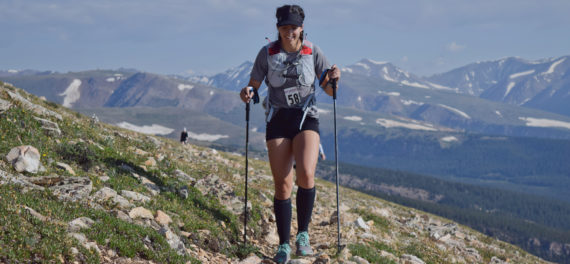By HPRS RD John Lacroix
As an ultramarathon runner, I tend to be a data driven individual. I know that many of you reading this, have a host of spreadsheets surrounding the many facets of your life. I also have a spreadsheet that lists every mountain I’ve ever climbed, and the date of ever time I’ve climbed it. I have a spreadsheet of every 4,000’ mountain in NH and the date in each month of the year that I’ve climbed each peak. I have a spreadsheet for every movie I’ve ever watched. While I don’t have a spreadsheet for everything, I have quite a few spreadsheets.
As far as ultrarunning goes, I have spreadsheets that cover every mile I have ever run in my 16 years as a runner. I have spreadsheets that list every ultra-finish, and DNF, with my average pace per mile for each finish. I have this data, so that when put all together I can extrapolate trends between my training and performance. I have a spreadsheet that details the entry fees for every ultra in the state of Colorado, so that I know the average entry fee for each ultra-distance in our market. I have a spreadsheet that keeps track of total finishers of every trail race half marathon or longer, in Colorado, going as far back as 2004… so I can extrapolate trends in which races thrive, and which ones are not thriving. I look for trends, so that I can do more of what works, and less of what doesn’t. I also look for trends, so we can create our own.
I’ve recently started creating spreadsheets that track every single finisher of every HPRS race. I can see how many years someone finished the old Tommyknocker 12-Hour or Mine Shaft Half; how many finishes someone has at Indian Creek, and so on. I’m doing this at the suggestion of our advisory board, who suggested our keeping track of our repeat runners and celebrating your various mileage “milestones” with you. I of course have a master spreadsheet of every online registration to our series since inception. Every event, every distance, all time, since 2014. If you registered online, your name is in my sheet. We compiled this information so that we could take a closer look at our demographic snapshot; By year, by the last 3 years, and all time. This information is invaluable, because it tells us how we’re doing on our mission and vision along the way.
Data can tell us a lot, and it rarely lies. There’s a huge trend in our world where individuals share “facts” through social media channels, that is void of any facts at all. Some refer to this as “Fake News.” Some folks love to share with you all about what they KNOW about a particular person or race series, when they lack the knowledge to have a complete and total picture of what they’re actually sharing.
Now, for the purposes of this discussion, I want to talk to you about some of that demographic data, and how it relates to the direction of our series over time. Data that is factual and doesn’t lie… real news. If someone can truly extrapolate truth from data, the ol’.. “The proof is in the pudding,” then I hope the information I am about to share will continue to shine a light on what matters most.. and that is, the people who continue to make this community what it actually is, and not what others say it is. I’ve heard a few times over the years, “John… I don’t care about your data man!” Data is important, it tells us a story, the story. The truth. It matters, especially in a world so recently fixated on the data of science. It doesn’t stop with science!
OUR GROWTH AND DEMOGRAPHIC BREAKDOWN
As has been stated pretty routinely since December, HPRS is the only major race series on the planet to host their entire 2020 calendar of in-person events without a single cancellation. We also set a registration record in 2020, our third year in a row doing so. No other series in Colorado has experienced the same exponential growth, year over year, as we have since 2017.
Here is a look at our percentage of growth of total registration numbers since 2017
2018 +107% over 2017
2019 +66% over 2018
2020 +17% over 2019.. during a global pandemic
Since 2014 we have handled over 6,800 registrations all time. 62% of those total registrations are male, and 38% are female. Our biggest age group is 30-39, followed second by 40-49
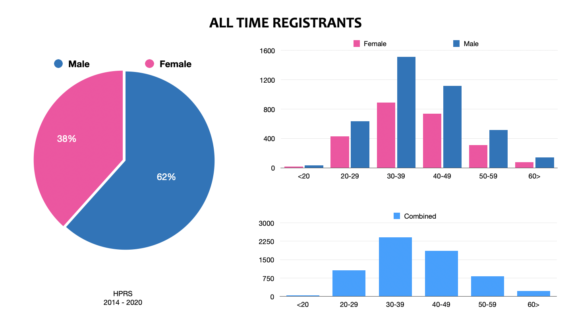
~~
Here is a density map of all locations in the lower 48 that our runners join us from, based on zip code.
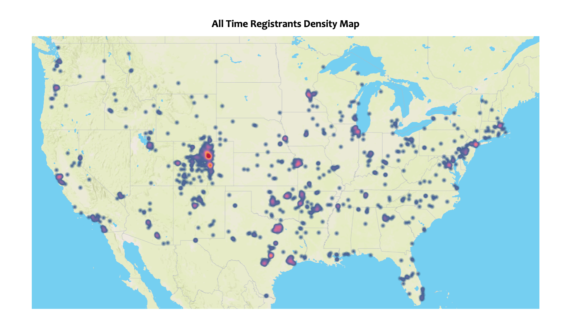
MALE PARTICIPATION TRENDS
Taking a look at our male participation trends:
2018 saw 104% growth over 2017
2019 saw 66% growth over 2018
2020 saw one less male registrant over 2019… or -0.09%
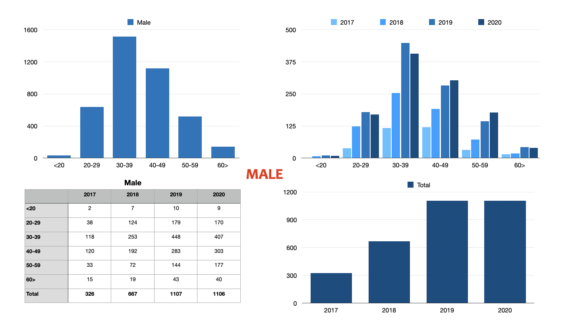
The two male age groups to grow over the last 3 seasons are male’s 40-49 and 50-59.
FEMALE PARTICIPATION TRENDS
This is the demographic I was most interested at looking into. Why? I’ll be honest… It’s no secret that there are rumors in our sport relating to women not running with HPRS since 2019. This exercise was imperative to me, because I wanted to know the truth based on what the data says. I can’t say that I was surprised, but I’d honestly never looked at our demographic data before. As someone who listens to the naysayers far more than I should, my brain has been programed to believe them. So that did it show?
Taking a look at our female participation trends:
2018 saw 104% growth over 2017
2019 saw 82% growth over 2018
2020 saw 14% growth over 2019.
The two fastest growing female age groups is 30-39 and 40-49, but the real story is the fact that compared to the men, the only female age group not to grow year-over-year since 2017 is the <20 age group. The growth in both the 30-39 and 40-49 age groups over the last two years is dramatic.
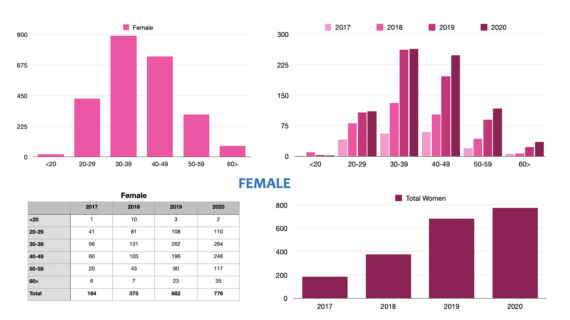
FEMALE vs. MALE
The next thing we looked at was the breakdown of participants as a percentage by gender. I went over to Ultrarunning Magazine’s website and compared our gender trends to the gender trends sport wide in the United States only. Here’s a look at the percentage breakdown (United States Only) according to Ultrarunning Magazine. Oh, and of note here. If you add up the numbers presented on UR Mag’s stats section on their website, most of these numbers add up to 103-105%. Apparently we’re really giving it our all out there…
 “THE PROOF IS IN THE PUDDING”
“THE PROOF IS IN THE PUDDING”
In 2017, the major conversation that took over the US ultra-community was gender inequality. Many of us spoke up and out about the need for us to bridge the gender gap, and to get more women involved. Some have said that the strides we’ve taken at HPRS have been “Faux Feminism” and not rooted in authenticity. I respectfully and wholeheartedly disagree. Those who talk the talk haven’t even been here since 2016, if ever… and we’re not just talking at HPRS, we’re walkin’ the walk.
As a series, HPRS has continued to focus on being a welcoming community for everyone, regardless of one’s sexual orientation, age, race, religion, or gender identity. I should note that we are an LGBTQ safe space, and the first race series in the sport with a black and white policy that treats transgender athletes with the respect of how they identify. We continue to do all of the things we implemented long before the national conversation even started, ensuring that women are treated with the same dignity and respect as athletes, as the men. We have a pregnancy deferral policy for women who may become pregnant on the trail to race day, and a “Complicated Pregnancy” Deferral policy for partners of pregnant women, that does not use language that identifies the partner of a pregnant woman as inherently male. We do women’s specific sizing on our race shirts. We look for gender neutral, or women specific, photographs and videos for our marketing initiatives. We have menstrual products at our races, we just don’t put them out on the table.. women can ask for what they need. But because we don’t check the box for having these items out on the table, we’re not “Trail Sisters Approved.” Which brings me to important questions… Is putting feminine products out in the open at a race enough to bridge the gender gap? How does providing women preferential treatment over men helping to encourage participation of one gender within our sport, without alienating those who identify as a different gender? Does this not seem counterintuitive?
While the gap between male and female participation in the US continues to move further apart, at HPRS it is most certainly moving closer together; and doing so in earnest over the last 2 years. You don’t have to be Trail Sisters approved to make a statement, or to bridge the gap, and the data speaks to that point. While I respect the mission and vision behind the Trail Sisters organization, I would respectfully challenge the Trail Sisters to see if races that hold a Trail Sister’s stamp of approval have increased their female participation. Has Trail Sisters adjusted their requirements for approval based on the community’s response to those rquirements?
The only “Faux Feminisim” I see in our sport, are the organizations that simply do the minimum of what is required to be labelled “Trail Sisters Approved.” What does a race organization need to do to actually provide an equal environment and community? It’s deeper than check boxes. (…That’s just the beginning.) It’s equality. It’s feeling safe. It’s feeling like you belong.
The answer to the gender gap is not to treat one gender group more favorably than another either. How about we start by no longer labelling young girls who want to play sports as “Tomboys?” Can we start there? Because every time you call a young girl a tomboy, you strip them of their identity as a woman, and call them a boy. No one in our sport wants a handicap or preferential treatment…no one. This is a sport built on community and grit. Everyone wants to feel like an equal. Plain and simple.
2021 is off to another amazing start as we are once again outpacing our 2020 numbers, post pandemic. Our 100% covid-guarantee provides our community with the peace of mind that we truly are people over profit. We have expanded into Southern California with 3 new races in San Diego. One of those new races is the SoCal Wine Country Women’s Half Marathon & 5k, our first women’s only event that we are proud to host in 2022 and beyond. Our male to female registrant ratio is still 59% Male, 41% Female. We will continue to do all of the things HPRS has always done to treat women the same as we treat men. I’m willing to guess that as we continue to work on strengthening our community these next 3-5 years, that we’ll continue to bridge the gender gap closer to 50/50. If there’s ever a series to do it, it’s this one.
I’ll let you go with this…
Of all the major ultrarunning series in the United States (5 or more races), we are one of the top 5th largest in number of events. I’m fairly certain that we’re the only one’s since the 2017 discussion that has inched this close to 50/50 between men and women participants, but we’ll never know until other series’ start sharing their data. I hope many more of you will join us in 2021 and beyond, to experience for yourself what truly does set us apart, and not just what you heard.
I heard Trump won the election…. the data says otherwise.
RELEVANT LINKS:
My Discussion From 2017 On Gender Inequality

